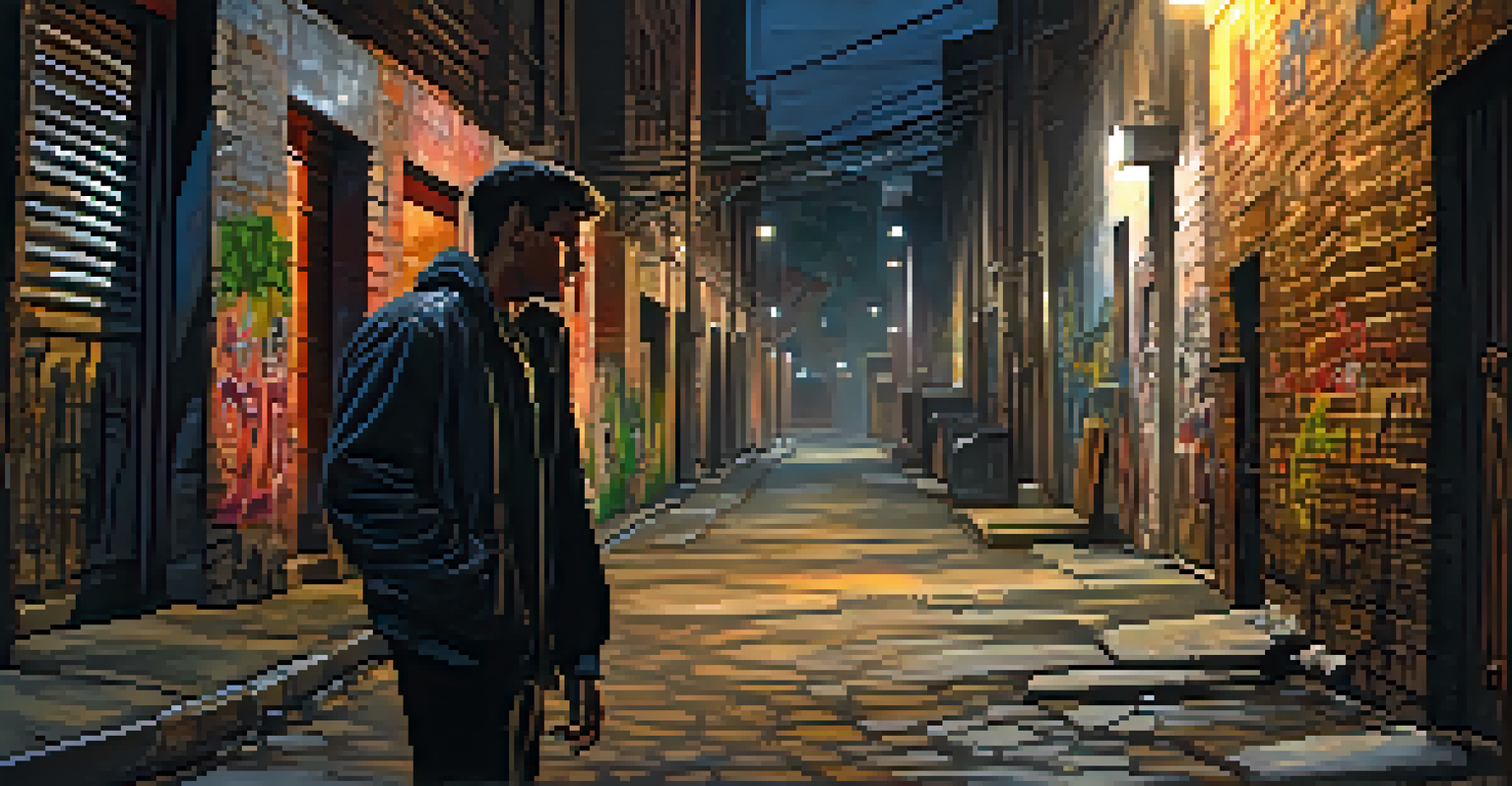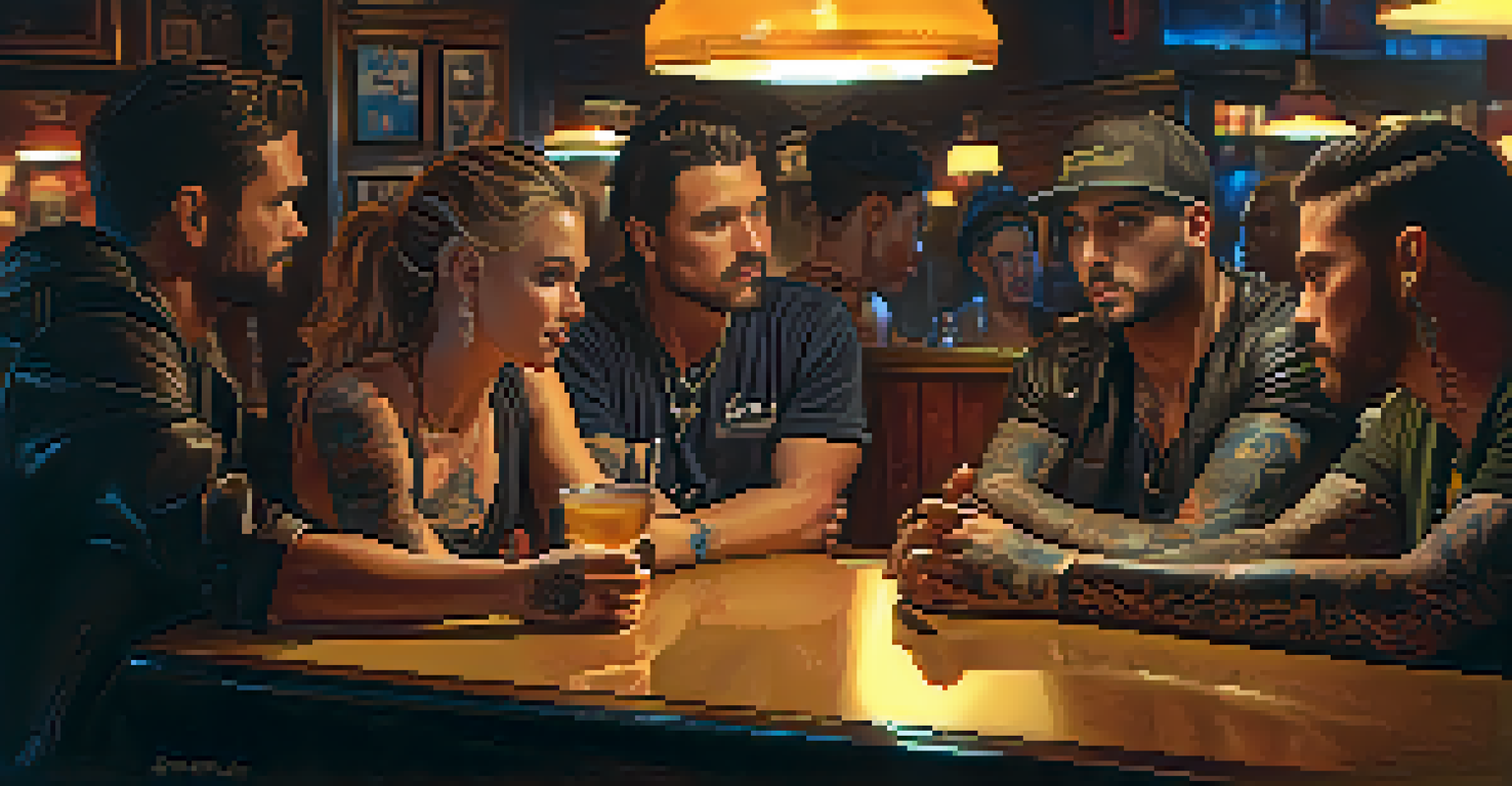The Antihero in Genre Films: Breaking Traditional Norms

Defining the Antihero: More Than Just a Villain
An antihero is a complex character who often lacks traditional heroic qualities, such as morality and idealism. Instead of being purely good, they operate in shades of gray, making them relatable and intriguing. Characters like Walter White from 'Breaking Bad' or Deadpool showcase this depth, often eliciting both sympathy and frustration from audiences.
The antihero is a character who challenges the traditional notions of right and wrong, inviting audiences to explore the gray areas of morality.
Unlike classic heroes who follow a clear moral compass, antiheroes often make questionable decisions that lead to unexpected consequences. This unpredictability keeps viewers on the edge of their seats, as they never know what to expect next. In doing so, they challenge our preconceived notions of right and wrong, prompting us to examine our values.
By breaking the mold of traditional heroism, antiheroes invite us to explore deeper themes of morality and personal struggle. They reflect the complexities of real life, where individuals often face dilemmas that don’t have straightforward answers. This nuanced portrayal resonates with contemporary audiences, who crave authenticity in storytelling.
Historical Context: The Antihero's Evolution in Film
The concept of the antihero isn't new; it has roots that trace back to early literature and film. Characters like Charles Foster Kane in 'Citizen Kane' or Rick Blaine in 'Casablanca' blurred the lines between hero and villain, setting the stage for future antiheroes. However, it wasn't until the late 20th century that this archetype gained significant traction in mainstream cinema.

The shift in societal values, especially during the 1960s and 70s, played a crucial role in the rise of the antihero. As audiences began to question authority and traditional values, films like 'The Graduate' and 'Easy Rider' embraced characters that embodied this rebellion. These films highlighted protagonists who were flawed and disillusioned, reflecting a growing discontent with societal norms.
Antiheroes Redefine Heroism
Antiheroes challenge traditional notions of heroism by operating in moral gray areas, making them more relatable and engaging.
As we moved into the 21st century, the antihero became a staple of modern storytelling. Series like 'The Sopranos' and films such as 'The Dark Knight' pushed the boundaries further, showcasing characters that were both captivating and morally ambiguous. This evolution illustrates how the antihero has transformed from a niche character to a mainstream phenomenon.
Subverting Expectations: How Antiheroes Challenge Norms
One of the most compelling aspects of antiheroes is their ability to subvert audience expectations. Unlike traditional heroes whose arcs typically follow a predictable path, antiheroes often exhibit unpredictable behavior that keeps viewers guessing. This unpredictability makes their journeys more engaging and relatable, as they mirror the complexities of real-life decisions.
In a world where perfection is unattainable, the flawed antihero resonates with us, reflecting our own struggles and complexities.
For instance, in 'Kill Bill', Beatrix Kiddo is driven by revenge, and her journey blurs the line between victim and villain. This dynamic forces the audience to wrestle with their feelings towards her actions, creating a rich narrative tension. The ability to root for someone who operates outside conventional morals is both captivating and thought-provoking.
By challenging norms, antiheroes encourage viewers to reflect on their own beliefs and values. They often reveal the darker aspects of human nature, prompting discussions about morality, justice, and redemption. This complexity adds depth to narratives, making them resonate on a more profound level with audiences.
The Role of Antiheroes in Genre Films
In the realm of genre films—from action to fantasy—antiheroes provide a fresh perspective that revitalizes tired tropes. They often disrupt the standard narrative structure, leading to unexpected plot twists and character developments. This is particularly evident in superhero films, where characters like Venom and the Punisher bring a darker, more complex lens to the genre.
Moreover, the antihero's journey often serves as a critique of the very genre conventions they inhabit. Take 'Guardians of the Galaxy,' where the ragtag team of misfits challenges traditional notions of heroism. By embracing their flaws and imperfections, they remind us that heroism can come in many forms, often far from the polished, idealized versions we expect.
Cultural Reflections in Storytelling
These characters often mirror societal issues, allowing audiences to confront complex emotions and cultural anxieties.
This shift not only enriches the storytelling but also broadens the appeal of genre films to diverse audiences. By introducing antiheroes, filmmakers create space for narratives that explore themes of redemption, identity, and moral ambiguity, making genre films more relatable and meaningful.
The Psychological Appeal of the Antihero
At the heart of the antihero's appeal is their psychological complexity—flaws and traumas that resonate with audiences. These characters often embody struggles that many people face, such as addiction, betrayal, or existential crises. This relatability fosters a deep emotional connection, allowing viewers to empathize with their journeys.
For example, Tony Stark's transformation from a self-absorbed billionaire to a selfless hero in 'Iron Man' illustrates this psychological depth. As he confronts his past mistakes and personal demons, audiences are drawn to his vulnerability. This evolution reflects a desire for redemption that resonates with our own life experiences.
The antihero's internal conflicts serve as a mirror for viewers, prompting them to confront their own struggles and moral dilemmas. By exploring these universal themes, filmmakers create narratives that are not only entertaining but also cathartic, encouraging audiences to reflect on their own lives and choices.
Cultural Reflections: Antiheroes and Society
Antiheroes often reflect the societal issues and cultural anxieties of their time. As we navigate through turbulent political landscapes and social upheavals, these characters become symbols of resistance and rebellion. Films like 'Joker' and 'Fight Club' capture the frustrations of disillusioned individuals, resonating with audiences grappling with their own feelings of alienation.
This cultural relevance is pivotal in understanding the antihero's place in modern storytelling. By mirroring societal issues, these characters help audiences process complex emotions and thoughts. They challenge norms and provoke important conversations about mental health, violence, and societal expectations.
The Future of Antiheroes
As storytelling evolves, antiheroes are set to become even more prominent, reflecting diverse experiences and deeper narratives.
Ultimately, the antihero serves as a reflection of our collective psyche, showcasing the struggles, aspirations, and discontent of society. This connection enhances the viewing experience, making it not just about entertainment, but also about understanding ourselves and the world around us.
The Future of Antiheroes in Genre Cinema
As we look ahead, the antihero's evolution in genre cinema shows no signs of slowing down. With audiences increasingly craving authenticity and complexity in storytelling, filmmakers are likely to continue exploring this archetype. The rise of streaming platforms has also opened new avenues for character-driven narratives, allowing for deeper exploration of antiheroic traits.
Moreover, as societal values continue to shift, the definition of the antihero may expand even further. We may see more diverse representations of antiheroes, reflecting a broader range of experiences and backgrounds. This evolution could lead to richer narratives that challenge existing norms and invite fresh perspectives.

In conclusion, the antihero's role in genre films is poised to become even more significant. By embracing the complexities of human nature, filmmakers can craft stories that resonate deeply with audiences, ensuring that the antihero remains a captivating and essential part of cinematic storytelling.